
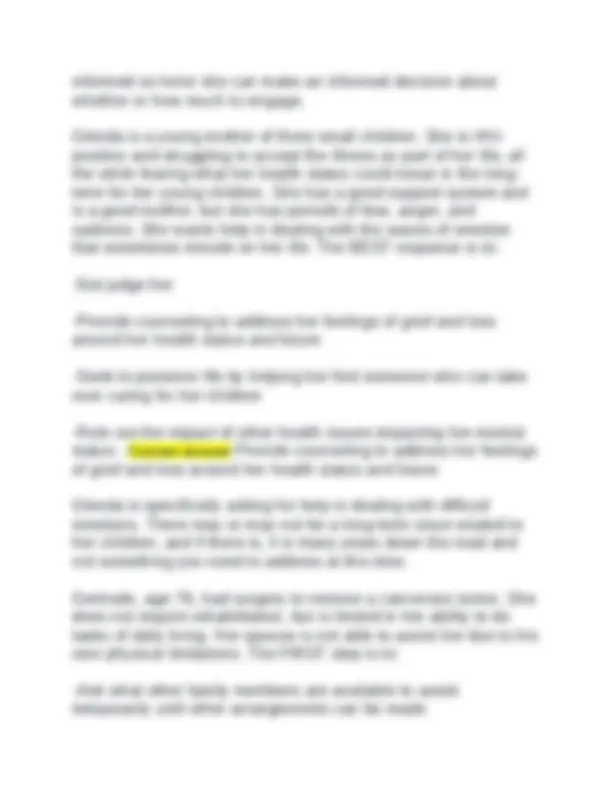
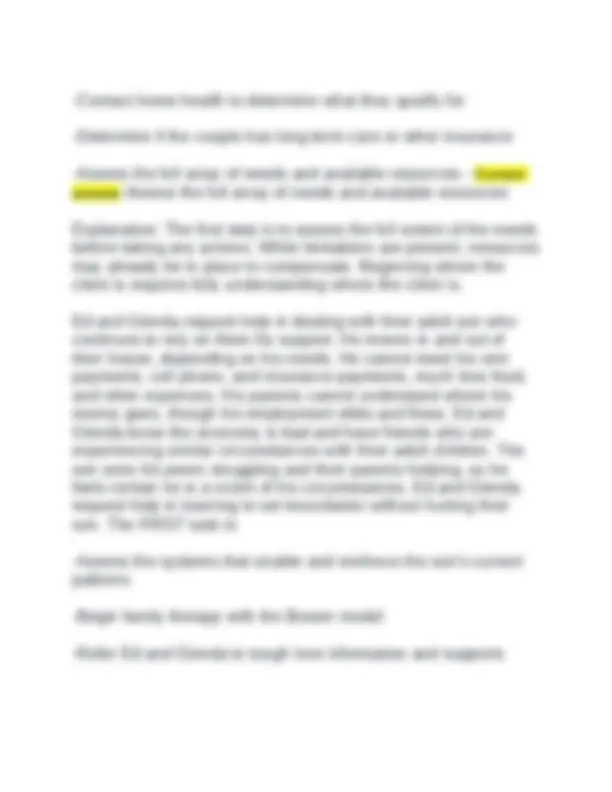
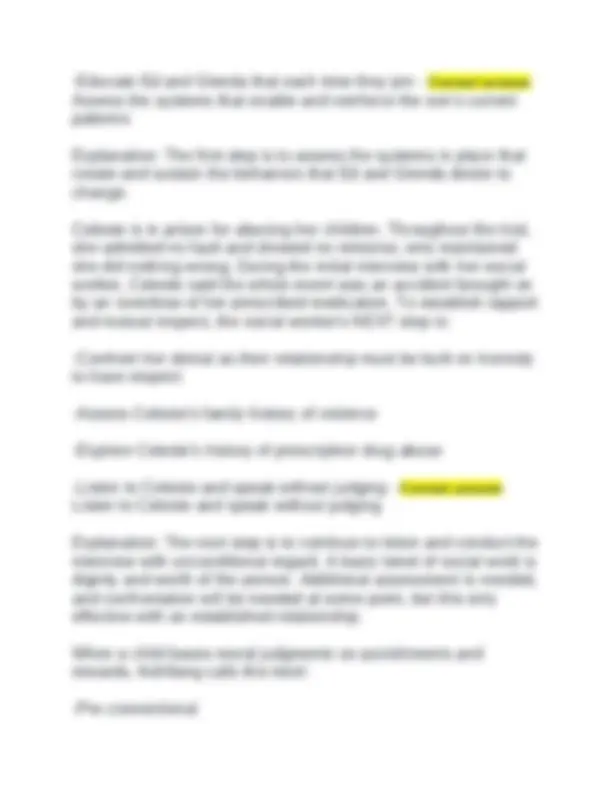
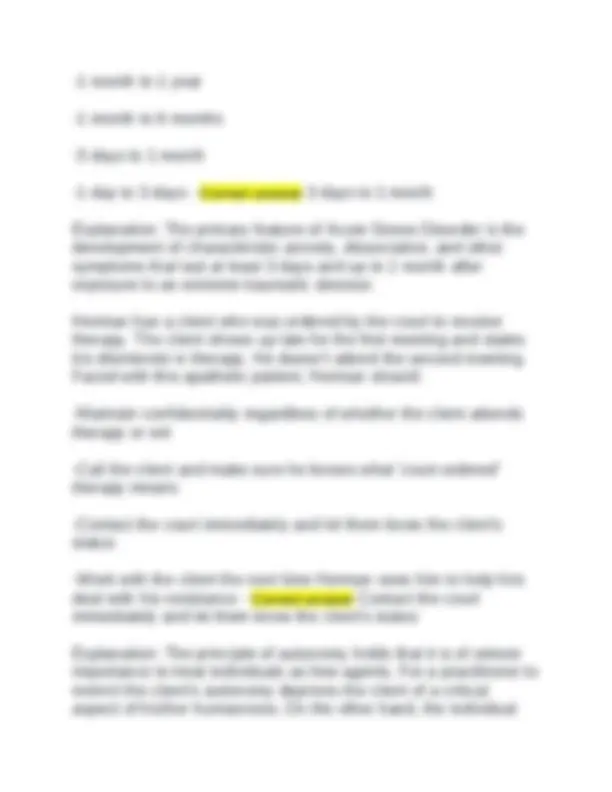

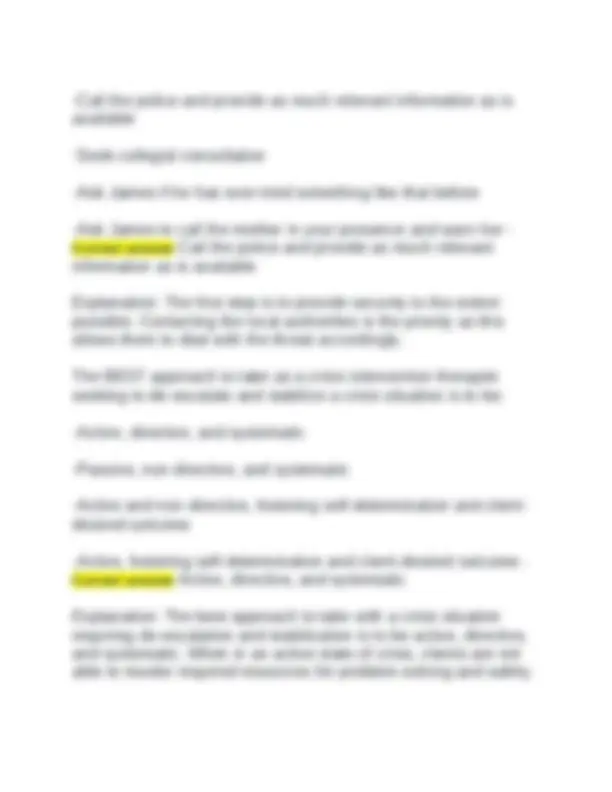
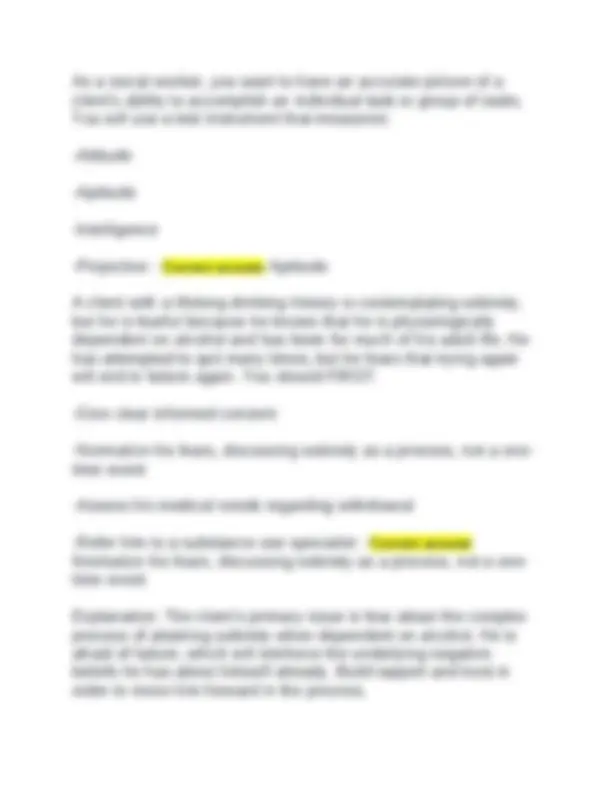
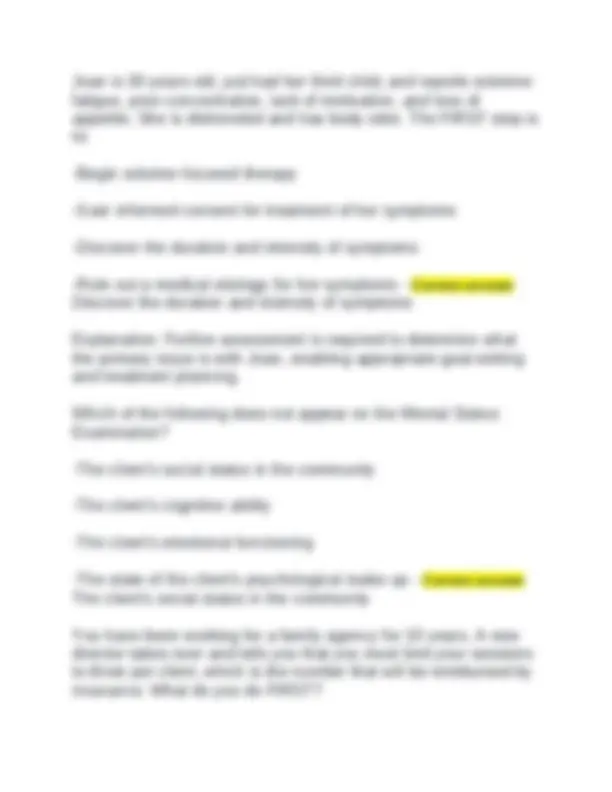
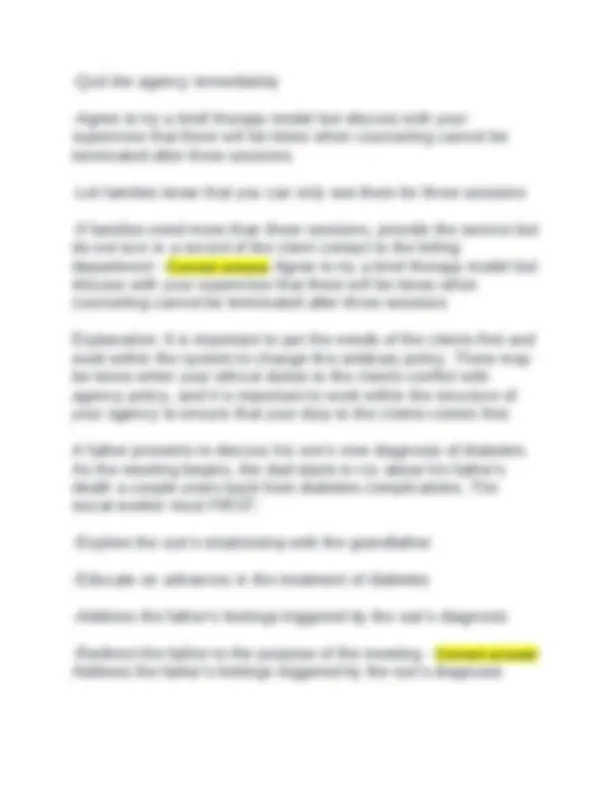
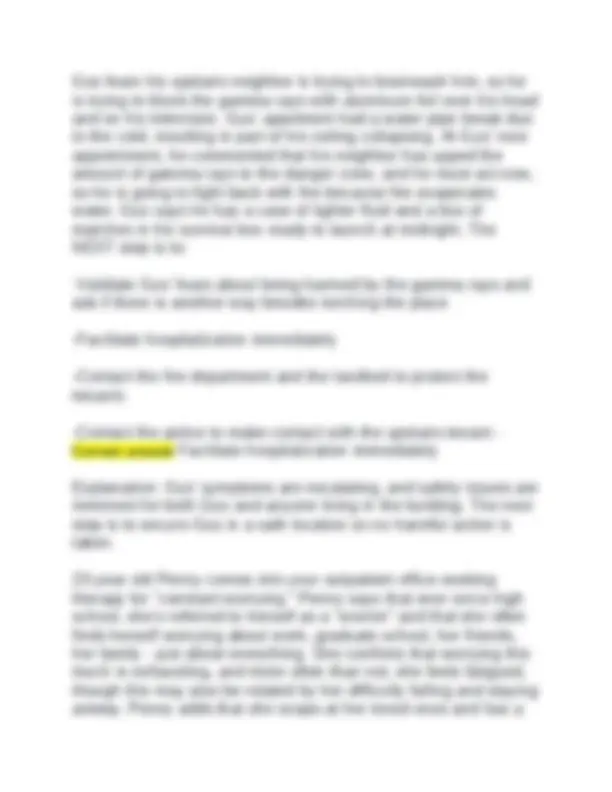
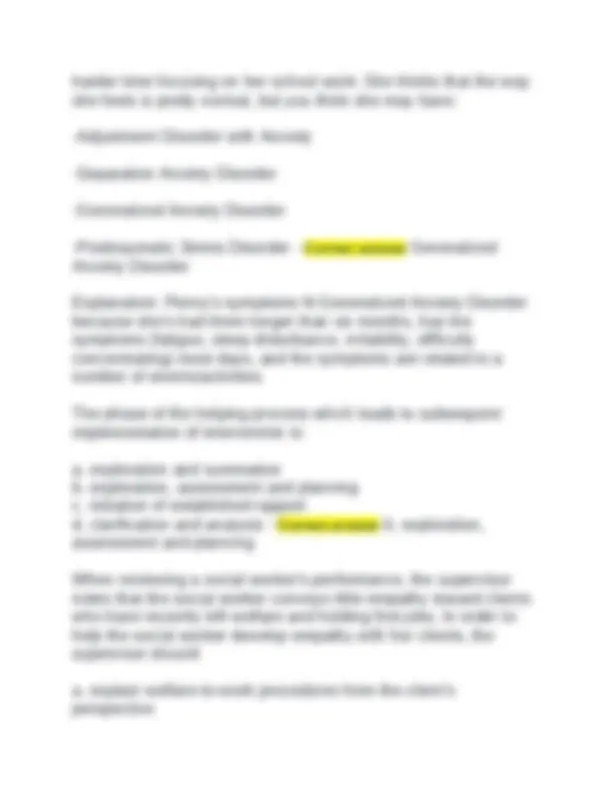
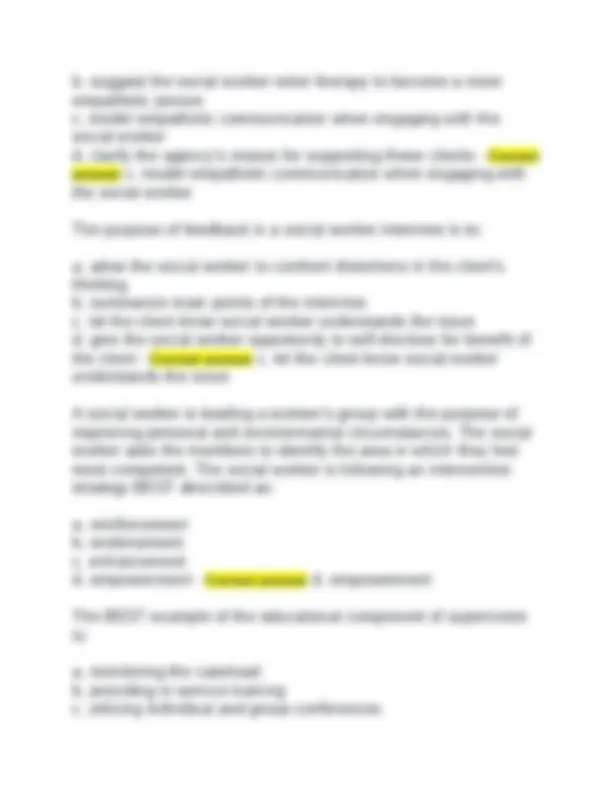
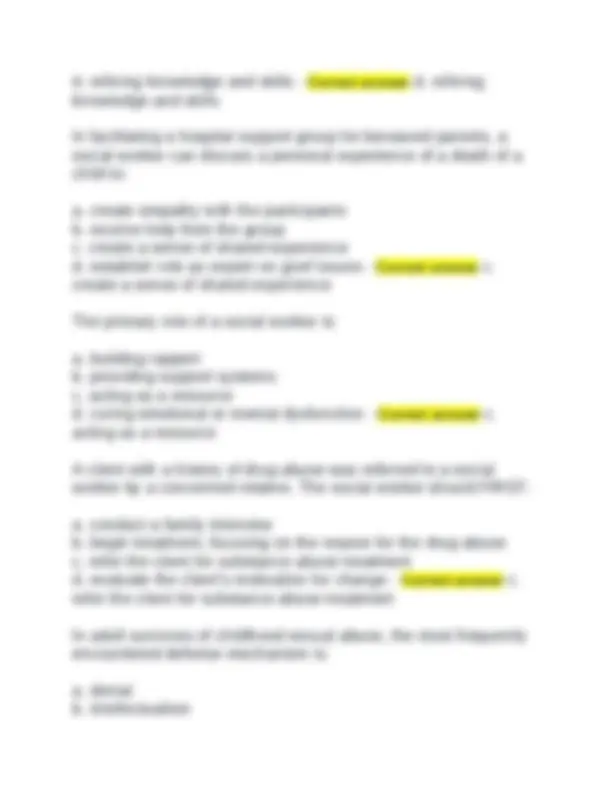
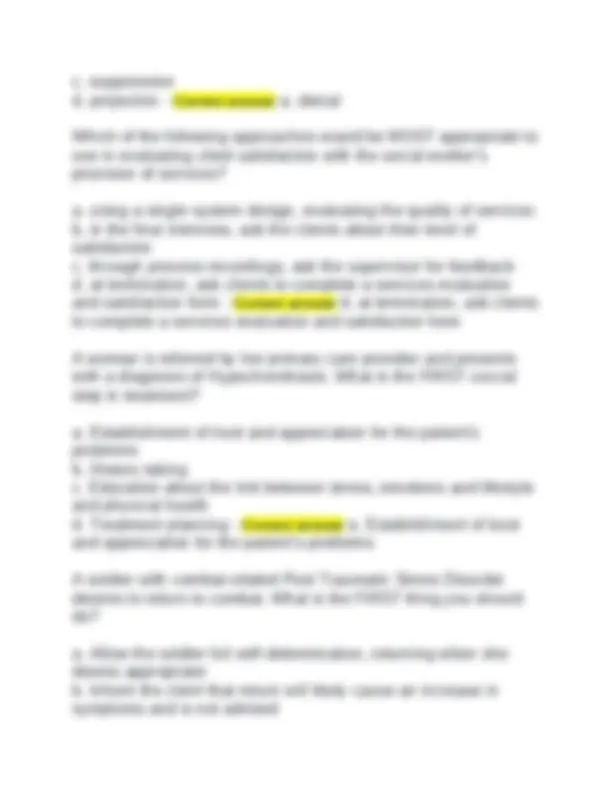
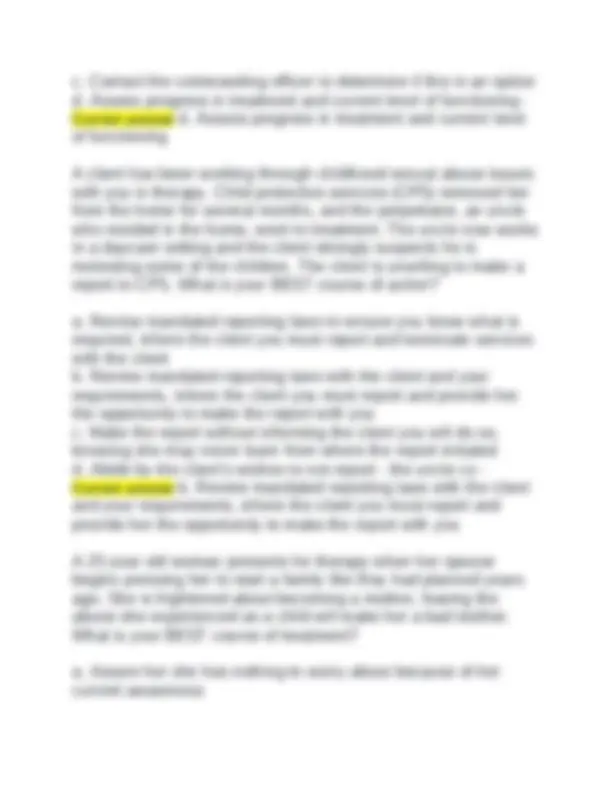
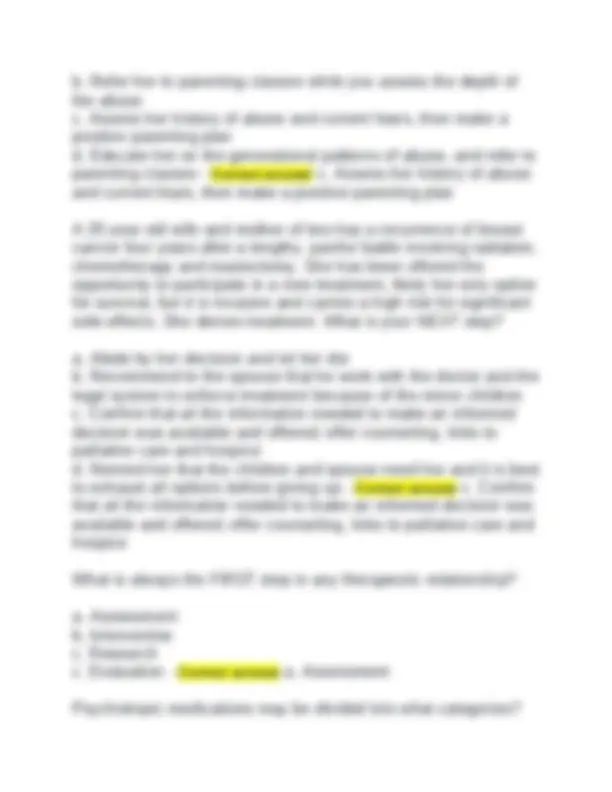
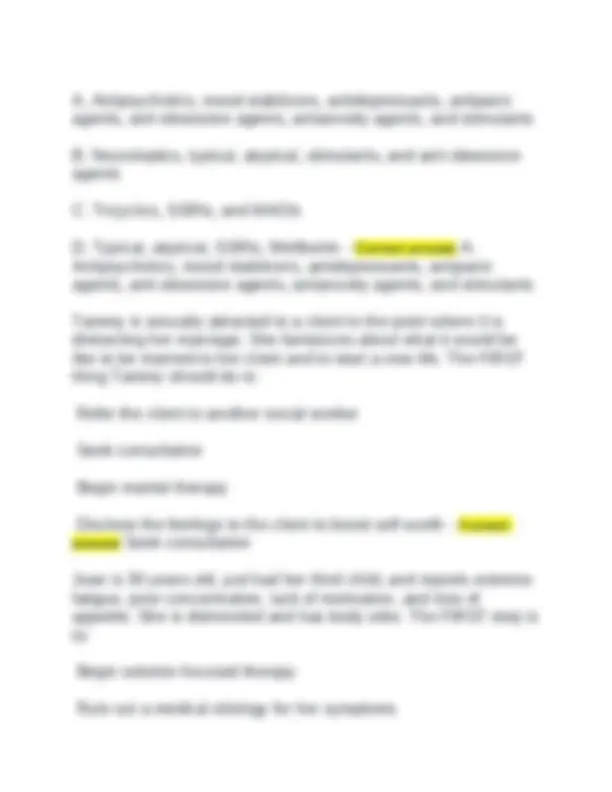
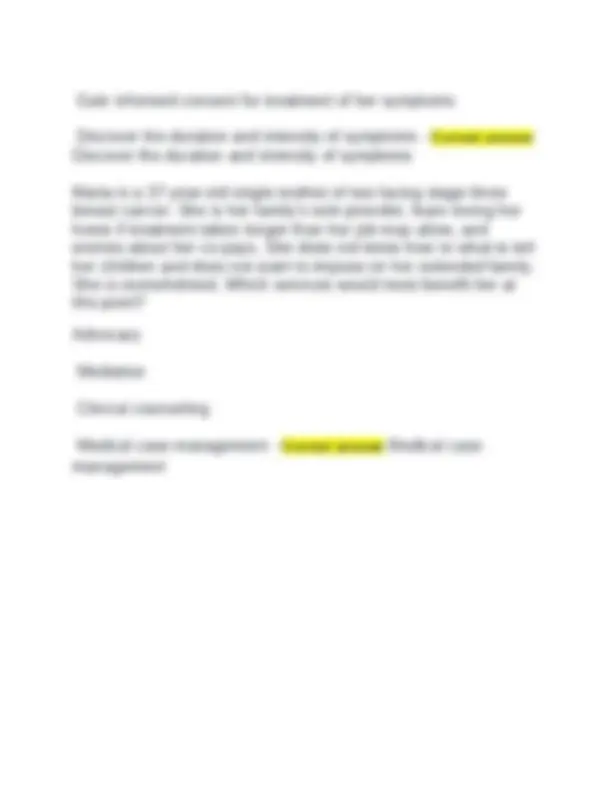


Study with the several resources on Docsity

Earn points by helping other students or get them with a premium plan


Prepare for your exams
Study with the several resources on Docsity

Earn points to download
Earn points by helping other students or get them with a premium plan
Community
Ask the community for help and clear up your study doubts
Discover the best universities in your country according to Docsity users
Free resources
Download our free guides on studying techniques, anxiety management strategies, and thesis advice from Docsity tutors
ASWB Clinical Exam Questions and Answers.ASWB Clinical Exam Questions and Answers.
Typology: Exams
1 / 26

This page cannot be seen from the preview
Don't miss anything!



















Richard presents with severe depression. He reports motivation for counseling services, but he is strongly opposed to medication. The FIRST thing to do is: -Acknowledge Richard's opposition and further assess any concerns about the treatment -Make a no-Suicide Contract -Get informed Consent to treat Richard's depression -Support Richard's self-determination to not take the medication. - Correct answer Acknowledge Richard's opposition and further assess any concerns about the treatment. A series of tornadoes hits a small town, and a woman presents at the disaster crisis center to speak with a crisis counselor. She is disheveled, and you are aware she has lost her home. What is the FIRST task to encourage in the session? -Let her tell her story -Relaxation techniques -Assess her situation -Problem-solving - Correct answer Let her tell her story The reliability of an assessment tool is an indicator of:
-Whether the assessment tool is measuring what it is supposed to measure -How dependable the assessment tool is -Faking good or faking bad -How effective the assessment tool is with different cultural populations - Correct answer How dependable the assessment tool is Carl is incarcerated and will be engaging in treatment for substance use as part of his sentence. He has questions about confidentiality. What is the BEST response? -Acknowledge the client's fears and assure him you cannot violate his trust -Validate Carl's concerns about confidentiality and ask him for more information -Provide information on limits of confidentiality and gain informed consent for treatment -Tell Carl that unless life is endangered, his or others, no violations of confidentiality will be made - Correct answer Provide information on limits of confidentiality and gain informed consent for treatment Clients who are incarcerated or are in treatment involuntarily still have the right to refuse treatment, and they have the right to understand who has access to information about their treatment and under what conditions. If there are specific reporting requirements, that must be provided. If reports are given to the courts, parole, or other entities, the client has a right to be
-Contact home health to determine what they qualify for -Determine if the couple has long-term care or other insurance -Assess the full array of needs and available resources - Correct answer Assess the full array of needs and available resources Explanation: The first step is to assess the full extent of the needs before taking any actions. While limitations are present, resources may already be in place to compensate. Beginning where the client is requires fully understanding where the client is. Ed and Glenda request help in dealing with their adult son who continues to rely on them for support. He moves in and out of their house, depending on his needs. He cannot meet his rent payments, cell phone, and insurance payments, much less food, and other expenses. His parents cannot understand where his money goes, though his employment ebbs and flows. Ed and Glenda know the economy is bad and have friends who are experiencing similar circumstances with their adult children. The son sees his peers struggling and their parents helping, so he feels certain he is a victim of his circumstances. Ed and Glenda request help in learning to set boundaries without hurting their son. The FIRST task is: -Assess the systems that enable and reinforce the son's current patterns -Begin family therapy with the Bowen model -Refer Ed and Glenda to tough love information and supports
-Educate Ed and Glenda that each time they pro - Correct answer Assess the systems that enable and reinforce the son's current patterns Explanation: The first step is to assess the systems in place that create and sustain the behaviors that Ed and Glenda desire to change. Celeste is in prison for abusing her children. Throughout the trial, she admitted no fault and showed no remorse, only maintained she did nothing wrong. During the initial interview with her social worker, Celeste said the whole event was an accident brought on by an overdose of her prescribed medication. To establish rapport and mutual respect, the social worker's NEXT step is: -Confront her denial as their relationship must be built on honesty to have respect -Assess Celeste's family history of violence -Explore Celeste's history of prescription drug abuse -Listen to Celeste and speak without judging - Correct answer Listen to Celeste and speak without judging Explanation: The next step is to continue to listen and conduct the interview with unconditional regard. A basic tenet of social work is dignity and worth of the person. Additional assessment is needed, and confrontation will be needed at some point, but this only effective with an established relationship. When a child bases moral judgments on punishments and rewards, Kohlberg calls this level: -Pre-conventional
-"It is overwhelming to work tirelessly and still feel like you don't measure up." - Correct answer "It is overwhelming to work tirelessly and still feel like you don't measure up." Explanation: Pam's feelings are irrational, but they are her feelings and you must begin where the client is, accepting her for who she is at her core (a mom who wants to care for her family), which will help establish rapport. Melanie just turned 17 and celebrated by going to a party with a girlfriend known for having fun. They went to a fraternity party, pretending to be students from a neighboring college. Melanie drank heavily and became sick several times. One boy convinced her to sit with him in his room, and she was taken by surprise when he forced her into sex. She was scared and could not fight him or even scream. He finally left, but another boy came in and did the same thing. She did not know what to do and was grateful when her friend grabbed her, and they got out. Melanie is afraid she could be pregnant or have an STD. She does not think she can tell her parents because she lied to them about where she was going and what she was doing. The only thing she can do now is cry. The FIRST priority is to: -Honor her feelings, while taking an active, directive role in linking Melanie to emergency health services -Link Melanie to publ - Correct answer Honor her feelings, while taking an active, directive role in linking Melanie to emergency health services Explanation: The first priority is to get Melanie a rape exam as quickly as possible, accessing emergency services. The duration criteria for Acute Stress Disorder is:
-1 month to 1 year -1 month to 6 months -3 days to 1 month -1 day to 3 days - Correct answer 3 days to 1 month Explanation: The primary feature of Acute Stress Disorder is the development of characteristic anxiety, dissociative, and other symptoms that last at least 3 days and up to 1 month after exposure to an extreme traumatic stressor. Herman has a client who was ordered by the court to receive therapy. The client shows up late for the first meeting and states his disinterest in therapy. He doesn't attend the second meeting. Faced with this apathetic patient, Herman should: -Maintain confidentiality regardless of whether the client attends therapy or not -Call the client and make sure he knows what 'court-ordered' therapy means -Contact the court immediately and let them know the client's status -Work with the client the next time Herman sees him to help him deal with his resistance - Correct answer Contact the court immediately and let them know the client's status Explanation: The principle of autonomy holds that it is of utmost importance to treat individuals as free agents. For a practitioner to restrict the client's autonomy deprives the client of a critical aspect of his/her humanness. On the other hand, the individual
-Call the police and provide as much relevant information as is available -Seek collegial consultation -Ask James if he has ever tried something like that before -Ask James to call the mother in your presence and warn her - Correct answer Call the police and provide as much relevant information as is available Explanation: The first step is to provide security to the extent possible. Contacting the local authorities is the priority as this allows them to deal with the threat accordingly. The BEST approach to take as a crisis intervention therapist seeking to de-escalate and stabilize a crisis situation is to be: -Active, directive, and systematic -Passive, non-directive, and systematic -Active and non-directive, fostering self-determination and client- desired outcome -Active, fostering self-determination and client-desired outcome - Correct answer Active, directive, and systematic Explanation: The best approach to take with a crisis situation requiring de-escalation and stabilization is to be active, directive, and systematic. When in an active state of crisis, clients are not able to muster required resources for problem-solving and safety.
A young couple presents for counseling following police intervention for domestic violence. He admits to drinking "a few too many sometimes, but usually only 8-10 beers." The FIRST step is to: -Provide informed consent for treatment -Instead of treating him, refer him to detox and addiction help -Assess for safety -Support the couple's right to self-determination - Correct answer Assess for safety Explanation: The first step is to assess the situation for safety to determine the level of threat present in the home, given current risk factors for age, police involvement, and alcohol. There is no indication he is currently intoxicated though he may be dependent and at risk for medical complications. Full assessment is required before a treatment plan can be presented or the couple can voice their desires for what may and may not be available to them. Joan is 60 and just retired after 30 years of teaching at a local community college. Joan felt good about herself when she worked, but now she wonders what she is worth and who she is outside of her professional life. Joan is married and has two grown children who are starting their own families. She feels out of place when she's around them, not knowing how she fits in. What is your FIRST assumption about the precipitating events from a life cycle theoretical perspective? -Conditions of worth imposed by the workplace and family -Problem-saturated story impacted by oppressive internalized view of self
As a social worker, you want to have an accurate picture of a client's ability to accomplish an individual task or group of tasks. You will use a test instrument that measures: -Attitude -Aptitude -Intelligence -Projection - Correct answer Aptitude A client with a lifelong drinking history is contemplating sobriety, but he is fearful because he knows that he is physiologically dependent on alcohol and has been for much of his adult life. He has attempted to quit many times, but he fears that trying again will end in failure again. You should FIRST: -Give clear informed consent -Normalize his fears, discussing sobriety as a process, not a one- time event -Assess his medical needs regarding withdrawal -Refer him to a substance use specialist - Correct answer Normalize his fears, discussing sobriety as a process, not a one- time event Explanation: The client's primary issue is fear about the complex process of attaining sobriety when dependent on alcohol. He is afraid of failure, which will reinforce the underlying negative beliefs he has about himself already. Build rapport and trust in order to move him forward in the process.
Joan is 30 years old, just had her third child, and reports extreme fatigue, poor concentration, lack of motivation, and loss of appetite. She is disheveled and has body odor. The FIRST step is to: -Begin solution-focused therapy -Gain informed consent for treatment of her symptoms -Discover the duration and intensity of symptoms -Rule out a medical etiology for her symptoms - Correct answer Discover the duration and intensity of symptoms Explanation: Further assessment is required to determine what the primary issue is with Joan, enabling appropriate goal-setting and treatment planning. Which of the following does not appear on the Mental Status Examination? -The client's social status in the community -The client's cognitive ability -The client's emotional functioning -The state of the client's psychological make-up - Correct answer The client's social status in the community You have been working for a family agency for 10 years. A new director takes over and tells you that you must limit your sessions to three per client, which is the number that will be reimbursed by insurance. What do you do FIRST?
Explanation: The first step is to begin where the dad is, which is feeling overwhelmed, as his son's diagnosis has triggered memories of his own father's death. Once the emotions are addressed, he will likely be a good advocate for his son because he is educated on the disease already. What he needs is support dealing with the new information. Christine has been described by her mother as a normal and healthy child since her birth. However, one and a half months ago she began regurgitating her food and re-chewing it after every meal. She has been checked by her primary medical physician who found no physiological symptoms, thus the referral to your practice. No other DSM-5 diagnostic symptoms are present except those described above. What is the most appropriate diagnosis? -Rumination Disorder -Enuresis -Conduct Disorder -Pica - Correct answer Rumination Disorder A retired couple is starting their "golden years" when one of them unexpectedly dies in an accident. She is left feeling stunned. Many friends and family surround her and offer support and encouragement. One of her friends brings her to you for counseling one month out from the accident. She engages easily but is clearly shaken by this unexpected tragedy, unsure of what the next many years hold for her. The FIRST course of action is to: -Educate her on the stages of grieving
-Provide short-term grief counseling -Refer her to a widow's support group -Assess her coping skills - Correct answer Assess her coping skills Explanation: The first step is to understand what her coping skills are, assessing for her inner and external resources to determine what, if any, course of treatment is needed. She has a network of friends and family, and until this is better assessed, it is unclear the make-up of this network, which may or may not constitute other widows. A 14-year-old girl is referred to a social worker after missing excessive days of school. Her family members are migrant workers from Central America. She often stays home to take care of her five younger siblings. Prior to meeting with the her parents, the social worker must FIRST: -Educate the parents on compulsory school attendance -Consider how to be culturally sensitive to the family roles -Make sure a social worker is available who speaks the family's native language -Consider how her role as a big sister will reflect as a role model - Correct answer Consider how to be culturally sensitive to the family roles Explanation: The first consideration is to be culturally sensitive to the family and how each member contributes to the well-being and survival of the family.
harder time focusing on her school work. She thinks that the way she feels is pretty normal, but you think she may have: -Adjustment Disorder with Anxiety -Separation Anxiety Disorder -Generalized Anxiety Disorder -Posttraumatic Stress Disorder - Correct answer Generalized Anxiety Disorder Explanation: Penny's symptoms fit Generalized Anxiety Disorder because she's had them longer than six months, has the symptoms (fatigue, sleep disturbance, irritability, difficulty concentrating) most days, and the symptoms are related to a number of events/activities. The phase of the helping process which leads to subsequent implementation of intervention is: a. exploration and summation b. exploration, assessment and planning c. initiation of established rapport d. clarification and analysis - Correct answer b. exploration, assessment and planning When reviewing a social worker's performance, the supervisor notes that the social worker conveys little empathy toward clients who have recently left welfare and holding first jobs. In order to help the social worker develop empathy with her clients, the supervisor should: a. explain welfare-to-work procedures from the client's perspective
b. suggest the social worker enter therapy to become a more empathetic person c. model empathetic communication when engaging with the social worker d. clarify the agency's reason for supporting these clients - Correct answer c. model empathetic communication when engaging with the social worker The purpose of feedback in a social worker interview is to: a. allow the social worker to confront distortions in the client's thinking b. summarize main points of the interview c. let the client know social worker understands the issue d. give the social worker opportunity to self-disclose for benefit of the client - Correct answer c. let the client know social worker understands the issue A social worker is leading a women's group with the purpose of improving personal and environmental circumstances. The social worker asks the members to identify the area in which they feel most competent. The social worker is following an intervention strategy BEST described as: a. reinforcement b. endorsement c. enhancement d. empowerment - Correct answer d. empowerment The BEST example of the educational component of supervision is: a. monitoring the caseload b. providing in-service training c. utilizing individual and group conferences